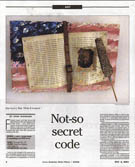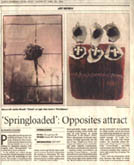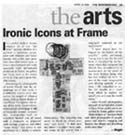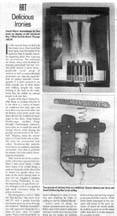 |
||
 |
||
 |
RECENT PRESS: Some Assembly Required for Artist Dan Levin Mischievous Allegory II |
|
 SCIENTIFIC AMERICANA: Dan Levin’s clever assemblage work, now at the Delphine Gallery, blurs the boundaries between art and science, leaning towards the former. He calls the show “code,” referring to DNA, but the real gist of the art is a funny secret code of his own devising. |
“Not-so Secret Code” > code < (recipe books & assemblages by DNA Levin), through Oct. 18, 2001, at Delphine Gallery By Josef Woodard Santa Barbara Newspress October 12, 2001 Friendly lunacy and logic do an odd kind of dance in the assemblage work of Dan Levin—aka DNA Levin. Levin’s current show, at the Delphine Gallery, is the kind of thoughtful yet wacky delight that might successfully transport one away from the pressing obsessions of the day. Levin is wise enough in his approach to the assemblage medium to understand that logic, even of a twisted variety, can prevent the appearance of randomness in work all about found objects. What we find in this show, despite its wild-eyed humor and hints of chaos, is a surprising cohesiveness of design, a series of variations on a particular theme. Some clues to meaning are tucked into the exhibition’s title, “> code < (recipe books & assemblages by DNA Levin).” Most of the pieces are “bookish,” in a broad sense, in that they involve varnished books affixed to wood, marked with various inversions of the DNA code. We can also read them (pun intended) as biological recipes and analogs to life in the age of digital code, when endless variations of one and zero define much of contemporary reality. A surreal appeal hovers over the show, generally, as Levin applies the usual technique of irrationally connected images. It’s a ploy designed to startle and amuse us, also to jar us out of our collective sense of what goes where. But behind these hijinx, which provoke thought and snickers, is a method of the artist’s careful devising. Or at least Levin gives that impression of rationality, probably a ruse underscoring this art about science. As much as anything, he seems to be is playing fast and loose with the theme of science vs. culture and analysis vs. raw states of nature, having fun at our expense, and we at his. The main structural trick at hand here is the way in which all manner of physical objects thrust out into three dimensions from these relief piece books. It’s as if to say that these objects—bones, teeth, a gnarly mesh of rusted metal in “Chaos Interupted,” the spent corn cob in “Red, White & Livestock—“ represent corporeal reality bites which can’t really be explained away by the garbled stream of code. Reality outs. In “Code,” a twirling stretch of wire agitates a pair of dice and alphabet blocks spelling out DNA. Jutting out from the pages is a small vial filled with alphabet soup noodles. In “Before the Land,” a row of anchovies (glistening, stiffened for posterity like the varnished books), appear in front of the familiar rows of code, out of which little crustacean claws also painting a wry portrait of early planetary life. Evolution gone haywire may be the basic punchline of “Freak Show,” a piece built from clock works, with a hammer that cracks open an egg to reveal a tiny corn cob. A mixed metaphor, a mixed salad. Genetic engineering is a general target in a piece like “Altered Seeds of Promise,” with a jar of sunflower seeds and petals mixed in with tiny firecrackers—the incendiary agent in the equation. Visible in a burnt-edged hole in the pages of the book in this piece is a bright yellow, plastic sunflower. Kinetic art—art requiring power outlets—is interspersed throughout the gallery, extending the atmosphere of a cerebral circus underway. “The Sound of Mutation” is a kooky charmer, an almost elegant construction of an animal jawbone, black swath of fur, and another rotating wire with awkwardly-spun dice hinting at an evolutionary crapshoot. Strangely, one of the most compelling pieces here is unlike the others, and balances minimalist form and commentary on the uneasy vortex where culture and science meet. “Chromosome” is basically a slowly rotating stack of badly warped vinyl records, whose string of raggedy shapes evokes some sort of molecular structure, intensely magnified in scale. But that science reference is only part of the story: it also triggers in the culturally-attuned side of us a twinge of pain over the destruction of music, perhaps even melancholy over the demise of vinyl in the marketplace. The thing just keeps spinning hypnotically around, lugubriously, crazily, asking to be understood but refusing to be neatly summed up. Such is the nature of Levin’s show, in which the mad scientist and the mad artist come out to play. |
 |
“Springloaded”: Opposites attract Dan Levin and Jackie Woods By Marina Walker Santa Barbara Newspress April 26, 1999 ...with love and raucous enthusiasm, Levin explores Christ as spiritual and cultural symbol. Levin grew up in a family that allowed him the freedom to explore religion as history and mythos. For him, the crucifix is a totem that represents ideology while creating commentary on contemporary populist beliefs (“Televangelism #1” is an actual television set blaring white noise and the sign of the cross superimposed over commercial programming). What makes Levin’s work more passionate than sociological, is the affinity the artist holds for genuine spirit behind Christian dogma. Though blatant in his satire, Levin’s work is suffused with inspiration and the joy of discovery. He is excited by his subject matter and by the beauty and underlying integrity of what has sometimes become a profoundly corrupted message. In “Lucky You,” Levin quilts the cross with fortune cookies. The randomly placed fortunes read: “Jesus say you very, very lucky.” “Le Vin Rouge”— one of the most dramatic pieces in the show—is a fountain running wine instead of water and Levin’s way of saying, “Do you get it?” Here, as in communion ritual, wine becomes the blood of Christ. Levin wants us to think about exactly what that means so he’s made a crucifix from metal piping and passed wine (replaced later with colored water) through it. Time and again Levin wants us to consider what we are saying to and about ourselves when we perpetuate the language of icons. |
 |
“Ironic Icons at Frame” By Duncan Wright Arts Editor Santa Barbara Independent April 8, 1999 “...it is definitely Levin’s work that carries the weight of religious irony, with an Easter theme of crucifixion throughout this series of his work. Levin’s three dimensional assemblage is full of ironically treated, in-your-face iconography—such as crucifixes hacked out of wood with a chainsaw, or plastered with savings coupons and titled “Jesus Saves.” But Levin is not motivated by a desire to satirize Christianity. “My intention was never to shock or offend anyone,” said Levin. “If that were my intent I wouldn’t have omitted some of the pieces that I originally rendered in my sketchbook.” I have always been intrigued by the history of the crucifix,” Levin continued, “being that it was the favored form of execution by the Romans when they occupied The Middle East, in addition to its involvement in the death of the most famous being who has ever walked the earth. As one of the most recognizable and alluring symbols of our time, I felt compelled to explore my mind’s eye as it sees the world today.” |
 |
“Delicious Ironies” Bill Anderson Santa Barbara Independent July 12, 1997 In his second show at Roy’s in that many years, Dan Levin has once again won the hearts of an audience that is usually known for digesting rather than ingesting the surroundings. The restaurant art venue, along with its more artistically patronized “art bar,” traditionally attracts a more demographically mixed group of viewers, as well as a more diversely motivated one, than the more hybrid art gallery network. Consequently, it is quite unusual to see folks actually out of their chairs and walking around the room looking at the stuff on the walls. Levin has the ability to compel people to do just that. The show is a cluster of found-art sculptures that spin, spit, and buzz their way into each other and art history. Levin pretty much crop dusts all over the modern art landscape in this show. From Francis Picabia-esque machine things through Duchampian semiotics, Levin goes on to touch the nose of George Herms while kissing the grunge-covered hand of Ed Kienholz. Skipping along the picture plane of Frank Stella only to liberally spray. ...in fact, the impression one gets from Levin’s work is of political and social conscience being the prime motivator. His strong pieces, such as “After the Thunderclap” (an old drawer from a bee keeper’s hive with a garden hose-like mechanism pouring water through the window), “Bazooka Novelette” (an old typewriter being fed by a sheet of pink cubes of bubble gum), “Farm Fresh Road Birth” (a paper carton of eggs partially broken to reveal black statuettes of the pope floating out of the shells), and “Sitcom” (a large wooden chair with its seat replaced by a floating TV spewing inane daytime TV programs) reveal a sharp wit and a willingness to slash at everyone and anything he finds repelling or ripe for rebuke/ridicule. Levin’s sense of design has stayed consistent since his last exhibit, and if this show is indicative of a year’s work, he is not one to be hung up for weeks on aesthetic conundrums. In fact, what is observed in this show is an apparent ease of working out design solutions that would make most painters turn teal with envy. But ironic and lyrical poetry, as well as highly evolved technical élan and riveting imagery is not part of Levin’s oeuvre. While Levin seems interested in the concepts and issues of the great geniuses of found-srt mixed media, he prefers to pinch us on the cheek rather than kick us in the stomach. Its a matter of style. |